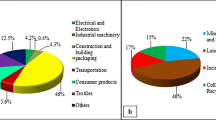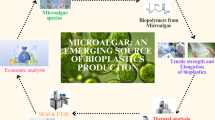Abstract
Oil spill containments are daily life problems due to inherent risks in transporting oil and diluted bitumen products via both tankers and pipelines. For oil–water separation, using a solidifier is one of the most efficient methods which triggers chemical interactions between the solidifier and the spilled oil to change the liquid phase of oil to a coherent mass, through a process called solidification. This study presents the performance of polypropylene (fibers, granule) and polyethylene granule solidifiers for oil spill cleanup by the gravimetric and spectrophotometric methods. The obtained results showed that polypropylene fibers have the highest sorption percentage (82.2%) and sorption capacity (12.5 g/g). The isothermal study reflects the Langmuir isotherm shows the good correlation coefficient (R2 = 0.93) for polypropylene fibers with consistency with the experimental data.




Similar content being viewed by others
References
Al-majed AA, Adebayo AR, Hossain ME (2012) A sustainable approach to controlling oil spills. Environ Manag 113:213–227
Barati A, Roshnasasl M, Hasannejad H (2015) Microcomposite synthesis of graphite gel of absorbent of oil spills from saline water surface. In: Sixth conference of water, wastewater and waste. https://www.civilica.com/Paper-PASAB06-PASAB06_036.html
Bazargan A, Tan J, Mckay G (2015) Standardization of oil sorbent performance testing. Test Eval 43(6):1271–1278
Jayselene J, Mohanraj S (2010) Solidification of hydrocarbon liquids using polymer blends. Dissertation, University of Auburn
Kutyanezhad H, Mola D, Keshavarz P (2012) The removal of crude oil, diesel and gasoline from polluted water by sorption with a natural soil sample. In: The first international conference on oil, gas, petrochemicals and power. https://www.civilica.com/Paper-ICOGPP01-ICOGPP01_562.html
Liu S, Xu Q, Latthe SS, Gurav AB, Xing R (2015) Superhydrophobic/superoleophilic magnetic polyurethane sponge for oil/water separation. RSC Adv 5(84):68293–68298
Lv N, Wang W, Peng S, Zhang H, Luo L (2018) Study of the kinetics and equilibrium of the adsorption of oils onto hydrophobic jute fiber modified via the sol–gel method. Environ Res Public Health 15(5):969
Motta FL, Stoyanov SR, Soares JBP (2018) Application of solidifiers for oil spill containment: a review. Chemosphere 194:837–846
Motta FL, Stoyanov SR, Soares JBP (2019) Chemosphere development and application of an amylopectin-graft-poly (methyl acrylate) solidifier for rapid and efficient containment and recovery of heavy oil spills in aqueous environments. Chemosphere 236:124352
Pourrahim Z, Dahrazma B (2009) The environmental impacts of oil transportation and modern methods of its purification. In: The first conference on transportation of hazardous materials and its environmental effects. https://www.civilica.com/Paper-HAZMAT01-HAZMAT01_107.html
Razavi Z, Mirghaffari N, Rezaei B (2014) Adsorption of crude and engine oils from water using raw rice husk. Water Sci Technol 69(5):947–952
Rosales PI, Suidan MT, Venosa AD (2010) A laboratory screening study on the use of solidifiers as a response tool to remove crude oil slicks on seawater. Chemosphere 80(4):389–395
Salehirad A, Haghighatkish M, Hosseini Varkiani M (2013) Use of non-textured polyester hollow fibers (polyethylene terephthalate) in collecting oil pollution. Oil Res 23(76):57–64
Songsaeng S, Thamyongkit P, Poompradub S (2019) Natural rubber/reduced-graphene oxide composite materials: morphological and oil adsorption properties for treatment of oil spills. Adv Res 20:79–89
Sundaravadivelu D, Suidan MT, Venosa AD, Rosales PI (2016) Characterization of solidifiers used for oil spill remediation chemosphere characterization of solidifiers used for oil spill remediation. Chemosphere 144:1490–1497
Tanobe VOA, Sydenstricker THD, Amico SC, Vargas JVC, Zawadzki SF (2009) Evaluation of flexible postconsumed polyurethane foams modified by polystyrene grafting as sorbent material for oil spills. Appl Polym Sci 111(4):1842–1849
Tawousi H, Shahkoei E (2013) Study of the newest methods of oil pollution removal from the sea surface. In: Sixth national conference on environmental engineering. https://www.civilica.com/Paper-CEE06-CEE06_074.html
Teli MD, Valia SP (2013) Acetylation of jute fiber to improve oil absorbency. Fibers Polym 14(6):915–919
Wu D, Fang L, Qin Y, Wu W, Mao C, Zhu H (2014) Oil sorbents with high sorption capacity, oil/water selectivity and reusability for oil spill cleanup. Mar Pollut Bull 84(1–2):263–267
Yu L, Gazi H, Shuai Z, Wei J (2016) Durable and modified foam for cleanup of oil contaminations and separation of oil–water mixtures. RSC Adv 6(29):24773–24779
Zaredust M, Rasouli M (2012) Comparison of performance of three types of synthetic adsorbent in the removal of oil pollution from the sea. In: Second national conference on wastewater and waste management in oil and energy industries. https://www.civilica.com/Paper-PASAB02-PASAB02_056.html
Acknowledgements
This work was supported by Islamic Azad University, Najafabad, Iran.
Author information
Authors and Affiliations
Corresponding author
Ethics declarations
Conflict of interest
There is no conflict of interest to declare in this study.
Additional information
Editorial responsibility: Samareh Mirkia.
Rights and permissions
About this article
Cite this article
Shojaei, N., Aminsharei, F. & Abbastabar Ahangar, H. Application of hydrophobic polymers as solidifiers for oil spill cleanup. Int. J. Environ. Sci. Technol. 18, 1419–1424 (2021). https://doi.org/10.1007/s13762-020-02882-y
Received:
Revised:
Accepted:
Published:
Issue Date:
DOI: https://doi.org/10.1007/s13762-020-02882-y




